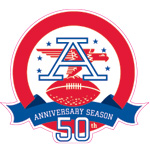AFL Assault
 When the founders of the American Football League were formulating a strategy to launch their newly formed pro circuit, they correctly realized that they needed a hook. The AFL had to stand out compared the “old guard” National Football League to capture the attention of the fans and keep them interested. The decision the league organizers made was that each team had to score. High-octane offenses that could register points at will would dazzle football fans and charge their appetite for more.
When the founders of the American Football League were formulating a strategy to launch their newly formed pro circuit, they correctly realized that they needed a hook. The AFL had to stand out compared the “old guard” National Football League to capture the attention of the fans and keep them interested. The decision the league organizers made was that each team had to score. High-octane offenses that could register points at will would dazzle football fans and charge their appetite for more.
{GALLERY}To help accomplish this, the AFL introduced a slimmer, more tapered ball which made it easier for teams to throw the ball. The leather on the aerodynamically-altered ball also had a tackier feel to it, which enabled receivers to more easily pluck the ball in midair while in flight.
The plan worked. In the AFL’s first season in 1960, each team scored an average of 24.2 points per game. In comparison, an NFL team’s average per game that same season was 21.5.
The majority of these offensive points can directly be attributed to a super-charged aerial attack. AFL quarterbacks and receivers posted eye-popping numbers throughout the 10 seasons that the league existed.
One particular player who benefitted greatly from the open style of play was Denver Broncos receiver Lionel Taylor. Not only did he lead the AFL in receptions from 1960 to 1963 and again in ‘65, but he posted the first 100-catch season in pro football history in 1961. In 1964 Charley Hennigan of the Houston Oilers bested Taylor’s mark by one when he hauled in 101 passes.
Quarterbacks also prospered in the pass-happy league. The Oilers’ George Blanda lifted his name atop the record books when he passed for 36 touchdowns on 3,330 yards in 1961. Then in 1967, New York Jets great Joe Namath passed for 4,007 yards to become the first quarterback to surpass the 4,000-yard plateau.
The vision the AFL founders conceived and employed was a wise one. The offenses that evolved from their early days in the league laid the foundation for many of the game plans that teams employ today.
AFL's Leading Receivers by Season
| Year | Player, Team | Receptions | Yards | TDs |
| 1960 | Lionel Taylor, Denver Broncos | 92 | 1,235 | 12 |
| 1961 | Lionel Taylor, Denver Broncos | 100 | 1,176 | 4 |
| 1962 | Lionel Taylor, Denver Broncos | 77 | 908 | 4 |
| 1963 | Lionel Taylor, Denver Broncos | 78 | 1,101 | 10 |
| 1964 | Charley Hennigan, Houston Oilers | 101 | 1,546 | 8 |
| 1965 | Lionel Taylor, Denver Broncos | 85 | 1,131 | 6 |
| 1966 | Lance Alworth#, San Diego Chargers | 73 | 1,383 | 13 |
| 1967 | George Sauer, New York Jets | 75 | 1,189 | 6 |
| 1968 | Lance Alworth#, San Diego Chargers | 68 | 1,312 | 10 |
| 1969 | Lance Alworth#, San Diego Chargers | 64 | 1,003 | 4 |
AFL's Leading Passers by Season
| Year | Player, Team | Att. | Comp. | Yards | TDs | INTs |
| 1960 | Jack Kemp, Los Angeles Chargers | 406 | 211 | 3,018 | 20 | 25 |
| 1961 | George Blanda#, Houston Oilers | 362 | 187 | 3,330 | 36 | 22 |
| 1962 | Len Dawson#, Dallas Texans | 310 | 189 | 2,759 | 29 | 17 |
| 1963 | Tobin Rote, San Diego Chargers | 286 | 170 | 2,510 | 20 | 17 |
| 1964 | Len Dawson#, Kansas City Chiefs | 354 | 199 | 2,879 | 30 | 18 |
| 1965 | John Hadl, San Diego Chargers | 348 | 174 | 2,798 | 20 | 21 |
| 1966 | Len Dawson#, Kansas City Chiefs | 284 | 159 | 2,527 | 26 | 10 |
| 1967 | Darryl Lamonica, Oakland Raiders | 425 | 220 | 3,228 | 30 | 20 |
| 1968 | Len Dawson#, Kansas City Chiefs | 224 | 131 | 2,109 | 17 | 9 |
| 1969 | Greg Cook, Cincinnati Bengals | 197 | 106 | 1,854 | 15 | 11 |
# - Member of the Pro Football Hall of Fame
 50 Years After - Follow Profootballhof.com all season long as we flashback to memorable moments and personalities that made the AFL a league to remember.
50 Years After - Follow Profootballhof.com all season long as we flashback to memorable moments and personalities that made the AFL a league to remember.
Road to Canton (via South Florida)
Now through Thanksgiving when the list of nominees is trimmed to 25, we’ll take a look at those players, coaches, and contributors that comprise the Class of 2010 candidates. This week our our focus is on the NINE QUARTERBACKS among this year's nominees.
McDaniel receives Hall of Fame ring
Class of 2009 enshrinee Randall McDaniel received his Hall of Fame ring at halftime of the Vikings-Packers game in Week 4.

